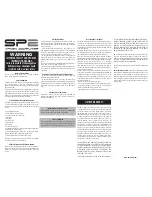
BX-240 • 19
© Box 73 Amateurfunkservice GmbH 2017
Measurement of Capacitance and
Inductance
When using on shortwave the manufacture
of a simple adapter of 2.54 mm pin con-
nectors and matching sockets serves to
conserve the SOL reference elements (see
paragraph
Calibration
). For measurement
the mode
Z One Frequency
is used. For the
existing measurement setup the target fre-
quency must be set and calibration carried
out from the menu item
SOL One Frequen-
cy
. The object to be measured is connected
directly to the selected setup and the ca-
pacitance or inductance at the target fre-
quency can be read on the display.
FA -VA4 as a Dip Meter
If a signal generating source (in our case
the analyzer) is loosely coupled in parallel
to a resonant circuit, a different energy ab-
sorption will be shown through the circuit
both at and outside of the oscillators reso-
nant frequency. This change also causes a
change to the displayed SWR value.
The loose circuit coupling is usually made
inductively; it is sufficient to place the an-
alyzer, with a coil (a wire) connected, close
to the resonant circuit. If using a ferrite ring
then the wire should be passed through the
core, at very low frequencies (
f
< 1MHz) a
test with several windings is helpful.
The SWR multi frequency measurement
must be set so that the expected resonant
frequency is set as the centre frequency. In
order to read the resonant frequency with
the highest degree of accuracy the mea-
surement interval should be reduced step
by step, this will be indicated by a clear
minimum SWR.
It is not always easy to find this minimum
as with high Q circuits the margins are
very narrow.
Determination of cable resonance
and resonant cables
The analyzer makes it easy to determine
points of resonance in coax and other RF
cables. Connecting an unknown cable to
the analyzer, the other end may be open or
short circuited. When the cable end is
open, points of resonance occur at
1
/
4
,
3
/
4
etc. of the wavelength of the resonant fre-
quency. With the cable shortcircuited the
resonant points are at
1
/
2
, 1,
3
/
2
etc. of the
wavelength of the resonant frequency.
Resonance means that the reactance of the
impedance is equal to zero, so here we
must use the ‘Z multi frequency’ measure-
ment. For shortwave it makes sense to
start with a centre frequency of 15 MHz
and a maximum measuring interval. The
resonances are indicated at the points at
which the reactance crosses the x- axis (ab-
solute zero). This frequency can be easily
manipulated in Marker Mode. This
method can also be used to make cable
resonators for a specific frequency. Thus
using the method set out in the following
paragraph a rough estimate of the physical
length can be made. A slightly long cable
may be trimmed until the target frequency
resonance is reached.
Determination of cable length and
shortening factor
Wavelength and physical length of a reso-
nant cable are linked by the shortening fac-
tor. Similar would be comparing the speed
of light velocity of a wave in free space to a
wave on a cable, the wave on the cable
propagates more slowly than in a vacuum.
For example RG58 co ax cable has shorten-
ing factor of 0.66 so the propagation speed
is only 198 000 km/s instead of 300 000
km/s.
Length, propagation speed and resonant fre-
quency are linked by the formula
v
l
=
–––
·
N .
f
N is a factor of
1
/
4
,
1
/
2
,
3
/
4
, and so on, de-
pending on which resonance point is con-
sidered and whether the cable is open or
short circuited at the other end. If the res-




































